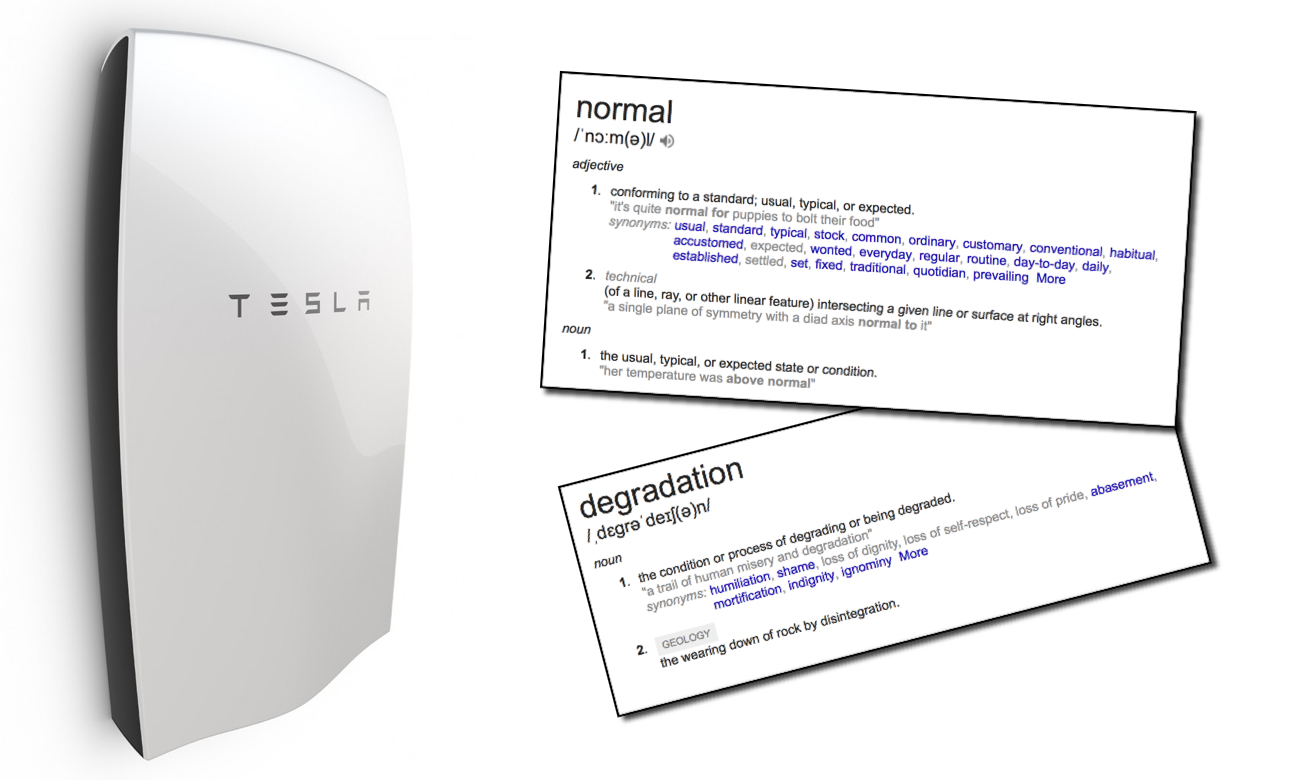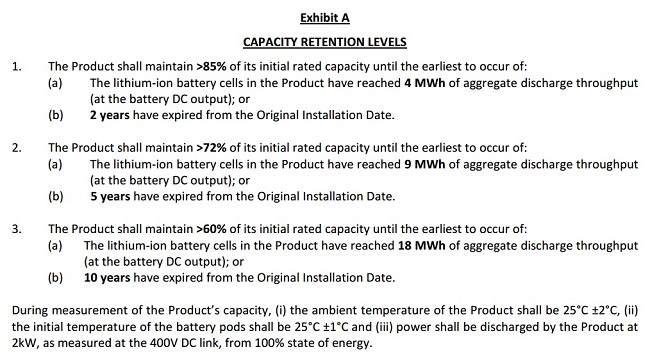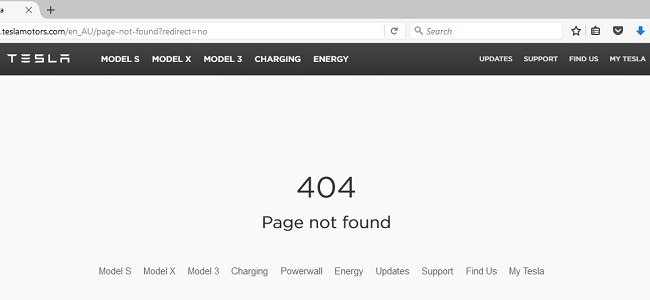
The new Powerwall warranty quietly introduced into Australia last month says you are not covered for ‘normal degradation’. Whatever that means.
Can I interest you in buying a revolutionary new energy storage system? It is called the Brakulator 7000. It has a usable storage capacity of 6.4 kilowatt-hours with a continuous power output of 3.3 kilowatts. And the great thing is it comes with a 10 year warranty.
Are you interested?
However, there is just one little thing I need to mention before you buy it. That 10 year warranty? It doesn’t cover normal degradation of your Brakulator 7000’s storage capacity over time.
What’s that? You want to know what “normal degradation” means? Well that’s too bad, because I’m not telling you. Your only option is to buy it without a definition.
If you are sure as hell you don’t want to buy a Brackulator 7000 without knowing what is meant by “normal degradation”, then you sure as hell won’t want to buy a Tesla Powerwall either, because its warranty, both here and in the United States, has been changed to contain exactly that phrase. I quote from the new Tesla Powerwall warranty effective from June 21st 2016:
“…this Limited Warranty does not cover (a) normal degradation of your Powerwall’s
energy capacity over time”.
No definition is provided for “normal degradation”.
I don’t have a law degree or anything, so I don’t know the proper legal term for this, but I’m pretty sure it is colloquially known as “bullshit”1.
Previously The Powerwall’s Warranty Was Disappointing But Clear
Before the 21st of last month how much degradation the Powerwall’s warranty covered was clearly spelled out. You can read about it here and there is a screenshot of the relevant part below:

A screen capture of the original Tesla Powerwall warranty.
It boils down to a promise it will provide at least 5.44 kilowatt-hours of storage for 740 cycles, followed by 4.6 kilowatt-hours of storage for 1,087 cycles, and then 3.84 kilowatt-hours of storage for technically 2,368 cycles, but its 10 year warranty period is likely to be over long before then.
This warranty was disappointing because, stupid me, I actually thought Tesla might be telling the truth when they originally promised a 7 kilowatt-hour energy storage system with a 10 year warranty. Such a thing was unprecedented, but they had done great things with electric cars, so I thought maybe they would also do great things with battery storage. I certainly wasn’t expecting them to provide a system they would only warrant an average of 4.39 kilowatt-hours over 10 years if it is cycled once per day.
But at least it was possible to see what you were getting. More than 5.44 kilowatt-hours of storage that you could expect to dwindle as its warranty ran out. But you don’t even get that with the Powerwall’s new warranty.

A screen capture of what you get if you go looking for the original Powerwall warranty on the Tesla site.
Why The Change?
When I first read the Powerwall’s disappointing original warranty I hoped it was so lousy simply because it was early days and once they were confident they had worked out any bugs, the warranty would improve. I definitely did not expect it to get worse.
The new warranty states the Powerwall can be cycled as many times as you like within its 10 year warranty period. That’s an improvement on the original warranty, all else being equal.
Unfortunately ‘unlimited cycles for 10 years’ is not very useful if the storage capacity is worn down to an almost useless nub after only 2,000 cycles and Tesla refuses to repair or replace it because they claim that is “normal degradation”.
Thankfully You Are Still Protected By Australian Consumer Law
Under Australian law you have a right to a repair, replacement, or refund if goods you purchase are faulty, unsafe, or do not work as they should. And this regardless of whether or not the product has a warranty or if the warranty has expired.
For example, if you buy a television with a 12 month warranty for $1,000 and it stops working after 13 months you still have a right to have it repaired or replaced, even though the warranty has expired. This is because it is reasonable to have expected a $1,000 TV to last longer than that. However, if you had paid $100 for the TV then you probably wouldn’t have a right to a repair or replacement because most people would not think it is unreasonable for an extremely cheap TV to break down after only 13 months.
So if you purchase a Tesla Powerwall and after a few years its performance is not what could reasonably be expected, then you have a right to have it repaired or replaced. And the important thing here is Tesla does not decide what is reasonable or what “normal degradation” is.
In practice – if you get into a disagreement with Tesla over what ‘normal degradation’ is then you’ll be off to your local Consumer Tribunal so a magistrate can decide.
Unfortunately, just what is normal degradation for a 6.4kWh shield-shaped battery pack is not clear. So if you do end up at a tribunal, the next part of this post may be useful.
What Is Normal Degradation For A Lithium-Ion Battery System?
Home energy storage is a new technology, so we don’t have a track record we can look at to determine what is reasonable performance or normal degradation. But we can get a good idea by looking at what sort of warranties are being provided for other lithium-ion battery systems.
Starting with the literal Mercedes-Benz of energy storage and going all the way to the lowest cost system I am aware of, the GCL E-KwBe, the warranted performance of a number of systems is shown below:
Mercedes-Benz Energy Storage Home: 80% of nominal capacity after 8,000 cycles.
SimpliPhi PHI3.4 Smart-Tech Battery: 80% of nominal storage capacity after 10,000 cycles.
Enphase AC Battery: 95% of nominal storage capacity after 7,300 cycles.
LG Chem RESU: 80% nominal storage capacity after 2,625 cycles.
GCL E-KwBe: 80% of nominal storage capacity after 2,000 cycles
The Tesla Powerwall is definitely not the most expensive storage system, but it is certainly not the cheapest. I guess its cost could be described as mediocre. But its original warranty, which promised at least 72% of its nominal storage capacity after 1,827 cycles, is horrible compared the budget priced GCL E-KwBe at 80% of nominal storage capacity after 2,000 cycles.
So Tesla may have been better off leaving its warranty as it was in Australia. That way at least they could claim that people should have been aware of how poorly it might perform over time. But now the Powerwall’s expected performance may be based upon what is reasonable for other battery systems around its price point.
I’ll Back You Up
I don’t know if I’m any kind of expert on anything. But I have written a lot about battery systems. So I’m willing to testify on what I believe a Tesla Powerwall’s performance should be and what “normal degradation” is.
It is my firm opinion that anyone whose Powerwall performs worse than its original warranty is entitled to a repair or replacement.
I’ll also state that the Powerwall’s performance should be similar to other lithium-ion battery systems of around its price point. It may be the worst performing one of the lot, but its performance should not be too far below the others and if it is you are also entitled to a repair or replacement.
So What The Hell Are Tesla Playing At?
Personally, I don’t believe that Tesla are evil corporates who want to stiff early adopters with a ambiguous warranty. I do believe they want to sell lots of Powerwalls and look after their customers.
I believe that Elon Musk genuinely wants to see the rapid spread of 24 hour solar power.
But if that’s the case, why would Tesla burden their early adopters with such a piss poor warranty?
The only reason I can guess at is this. Tesla realised that their original warranty was terrible and was costing them sales. Here at SolarQuotes we’ve spoken to plenty of people that won’t go near one once they read about the warranty conditions.
So I’m guessing that their legal team’s solution was to re-word it to be as non-specific as possible. Bloody lawyers.
Don’t Buy A Tesla Powerwall With This Warranty
Before Tesla changed its Powerwall warranty my recommendation would have been not to buy one unless you understood and were happy with the degradation figures in the original warranty.
But now they have changed their warranty so it doesn’t define or cover “normal degradation”, my recommendation is, hell no. Don’t go there until they sort their warranty out. Early adopters who spend big bucks to support solar and storage deserve better.
Footnotes
- Bullshit is a term that refers to communication that is regarded as deliberately vague. It is also used to refer to material that periodically emerges from a bull’s rear end ↩

 RSS - Posts
RSS - Posts



I’m going to stick with my lead acid batteries for the time being. As long as they’re balanced monthly they work just fine!
forgive my ignorance but what does it mean when u say your batteries are balanced every month. Thanks
Batteries connected in a string – even under very similar operating conditions – will begin to deviate slightly from each other; both in terms of state of charge, and cell voltage. This is (probably) a function of minute differences in the manufacturing process, but the long and short of it is that over time these deviations begin to widen, pulling the performance of your string down to that of the weakest performing cell.
A balancing event, sometimes called a refresh, pushes the charge of these batteries back up to their maximum, so that they can all perform at their best again.
Hi Ronald,
A very good bit of information as usual.
As Jon A says: I am saying exactly the same. I will leave those lithium type pie in the sky batteries alone for a long time.
Li-ion batteries are the future. The dinosaur lead acid batteries will become extinct since Li-ion are superior in every way to lead acid- except price. It is only a matter of time.
If you want a battery that looks good get a Tesla. If you want one that works, it’s cheaper and actually guarantees 80% after 10 years get a BYD B-BOX.
It’s an absolute plug-and-play and doesn’t require you to control the discharge levels or balance it.
It is highly unlikely that Enphase, Mercedes, or SimpliPhi will see the performance degradation they claim. It will undoubtedly be worse even with Li-ion cells that use LFP cathodes, which typically have better cycle life than NMC and NCA cathodes.
I am waiting until I can go off the grid completely. When I had my solar system put on, the best 3 months of the year I got a $10 credit, I also get a pension discount, feed in return 44 cents my biggest quarterly bill was $70. Now Ergon energy has put it’s prices up so much I pay around $220 for most of the year also they have just extended the peak use up to 9PM during the best 3 months of useful sunlight, so I expect my bills to be just about the same. Greedy sods and we don’t have a choice of providers. I do enjoy your information You send me Thanks.
Anyone have an opinion on the Redflow batteries. They are zink bromide and are suppose to have a far greater life cycle than lithium ion.
Hi Josh. I wrote about the Redflow Zcell zinc-bromide battery here:
https://www.solarquotes.com.au/blog/redflows-zinc-bromide-zcell-battery-may-have-the-edge-over-lithium-ion/
Tesla know exactly what a good degradation rate is for a good Powerwall2, they monitor every (internet connected) Powerwall2.
Initial Powerwall2:
1) was delivered & almost installed on 2022-03-07.
2) was (finally) commissioned correctly on a single phase in a 3 Phase environment of 2022-03-15
3) failed completely on 2022-05-04 when there was a VERY LOUD BANG, due to an internal DC fault.
Replacement Powerwall2:
4) The warranty replacement Powerwall2 was commissioned on Monday afternoon 2022-06-06.
The currently active Powerwall2 is not very good, as at ~18 months the Powerwall2 is showing a degradation rate of 9%, 91% of warranted capacity of 13.2kWh.
It is actually worse than this because the calculations are done using the Tesla recorded install date of 2022-03-07, which is really 2022-06-06 for the currently active Powerwall2.
Note: To quickly understand what the degradation rate of your Powerwall2, install the Windows “Powerwall Companion” version 04.10.0.0 or later. (Click on “Battery Stats” icon, in the left column (Windows ONLY))
On Android click on “settings” select “Powerwall stats” under “Extra Info”.
Note: At the moment on Android, only the available “Total Capacity” is displayed at the bottom of the page.
Or do the calculations as presented by SolarQuotes WEB site.
Now the clincher…
Why is my Powerwall2 is bad?
The Tesla Powerwall2 was selected & installed due to friend who installed a Powerwall2 on 2020-09-16, which is, let’s say 3 years plus old.
That Powerwall2 has a very similar usage, with at least 1 cycle per day, except when away on holidays.
What is its’ current degradation rate, as of 2024-01-05? (over 3 years old)
-2% (yes, minus 2%)
Current Capacity: 13.45kWh
That is 102% on the warranted capacity of 13.2kWh
I would like a Powerwall2 Battery with the same quality of lithium battery as in the Powerwall2 of my friend down the road.
Note: My Powerwall2 installed environment is much better than his.
(by env specs)
Any thoughts on the new PowerWall 2.0 just announced?
Looking forward to an in depth review of that being added to the site.
There is already a write up on the blog:
http://www.solarquotes.com.au/blog/tesla-powerwall-2/
And we’ll keep you updated as more information comes to light.